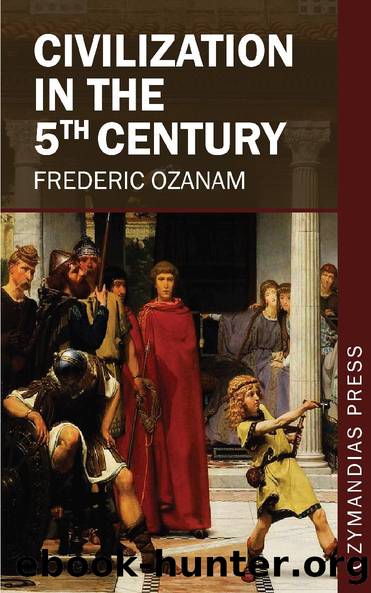Civilization in the 5th Century by Frederic Ozanam

Author:Frederic Ozanam
Language: eng
Format: epub
Publisher: Pronoun
THE INSTITUTIONS OF CHRISTENDOM (THE PAPACY AND MONASTICISM).
IN OUR ATTEMPTED EXAMINATION of the philosophy of St. Augustine, we have seen how his great genius, the true representative of Christian eclecticism, reunited the two methods which had, up to his time, under the names of intuition and reasoning, love and intelligence, mysticism and dogmatism, divided the world of thought. We followed him along the ways which lead to the knowledge of God; and on scaling the vast heights of speculation to which he had been our guide, perceived that it was his metaphysical system which enlightened, dominated, and influenced the lofty minds of the Middle Age. For whilst the mysticism of the “ Confessions” was to inspire the contemplation of Hugh and Richard of St. Victor, and draw from Bonaventura his “Itinerarium Mentis ad Deum,” St. Augustine’s demonstration of God’s existence was to be rigorously drawn out to its conclusions by St. Anselm, and to become an element in the “Summa Contra Gentes” of St. Thomas Aquinas, in which that great master undertook to prove, without recourse to Holy Writ, three hundred and thirty-six theses upon God, the soul, and their relations one with another.
But the remembrance of St. Augustine could not fill the domain of theology without descending into those arts which the Sacred Science inspired. Legend, as we know, had, as it were, seized upon the great doctor of Hippo, and woven around him an especial glory, as for instance in the vision of the sainted host granted to a monk in ecstasy, whose astonishment at not beholding St. Augustine was dissipated by the intelligence that his place was higher far, on heaven’s very summit, and veiled by the rays of that Divinity which it was the work of his eternity to contemplate. Nor was it surprising that monks should cling to his memory thus, when even the Saracens, encamped on the ruins of Hippo, showed their devotion to its bishop; and considering that in our own day the Bedouins of the neighbourhood of Bona come every Friday to the spot which is marked by the ruins of the Basilica of St. Augustine, to honour a hero whom they call mysteriously the great Roman, or the great Christian. Painting, too, found in the history of this Saint an inexhaustible store of subject, and, amongst others, Benozzo Gonzali has depicted the incidents of his life in ten paintings in the church of San Gemignano—that charming town of Tuscany which defies the curiosity of the traveller from its rocky site—paintings which, with touching simplicity, unfold the various epochs in his career, from the day on which he was taken by his parents to school at Tagaste, praying God that he might escape the rod.
Thus did the highest intellects of Christian Italy aim to draw near to that genius of old time. Petrarch, in writing his treatise on Contempt for the World, tormented by a passion that robbed his mind of all repose, imagined that he had St. Augustine for an interrogator,
Download
This site does not store any files on its server. We only index and link to content provided by other sites. Please contact the content providers to delete copyright contents if any and email us, we'll remove relevant links or contents immediately.
Resisting Happiness by Matthew Kelly(3200)
The Social Psychology of Inequality by Unknown(2771)
Designing Your Life by Bill Burnett(2605)
Day by Elie Wiesel(2599)
The Giving Tree by Shel Silverstein(2178)
Angels of God: The Bible, the Church and the Heavenly Hosts by Mike Aquilina(1871)
Human Design by Chetan Parkyn(1859)
The Supreme Gift by Paulo Coelho(1802)
Jesus of Nazareth by Joseph Ratzinger(1710)
Augustine: Conversions to Confessions by Robin Lane Fox(1688)
Hostage to the Devil by Malachi Martin(1676)
7 Secrets of Divine Mercy by Vinny Flynn(1623)
Dark Mysteries of the Vatican by H. Paul Jeffers(1607)
The Vatican Pimpernel by Brian Fleming(1589)
St. Thomas Aquinas by G. K. Chesterton(1558)
Saints & Angels by Doreen Virtue(1532)
The Ratline by Philippe Sands(1425)
My Daily Catholic Bible, NABRE by Thigpen Edited by Dr. Paul(1418)
Called to Life by Jacques Philippe(1410)
